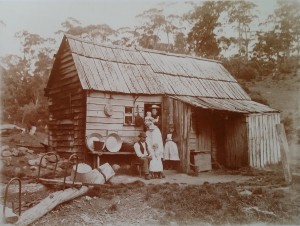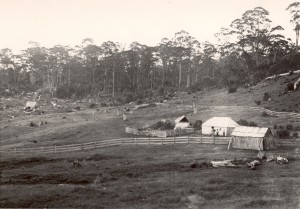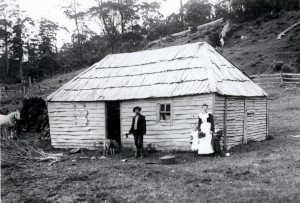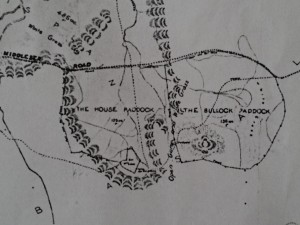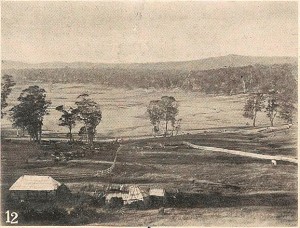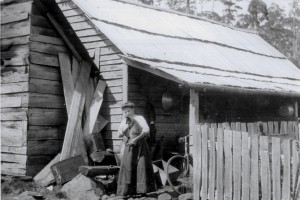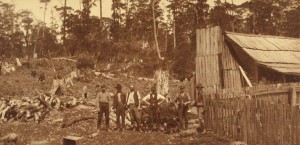Tired of Kindling Kindred? [1] Well, here’s the original Cradle Mountain gushfest. The papers of Launceston mountaineer Fred Smithies contain a fictional account of a visit to Gustav Weindorfer’s Cradle Valley tourist resort Waldheim a century ago.[2] The author of ‘A dip into the Waldheim mailbag’ used fictional letters written home from Waldheim by the visitors to describe the events of the fictional trip. The imaginary party consisted of John and Grace Moore, their daughter Mona Moore, their niece Claudia Crane—and a visiting boy named Percy Lane. The author, who had obviously stayed at Waldheim, gushed high-spirited prose to the rhythms of Bob Quaile’s wagonette ride from Wilmot to Waldheim via Daisy Dell, and continued the girlish banter with Weindorfer.
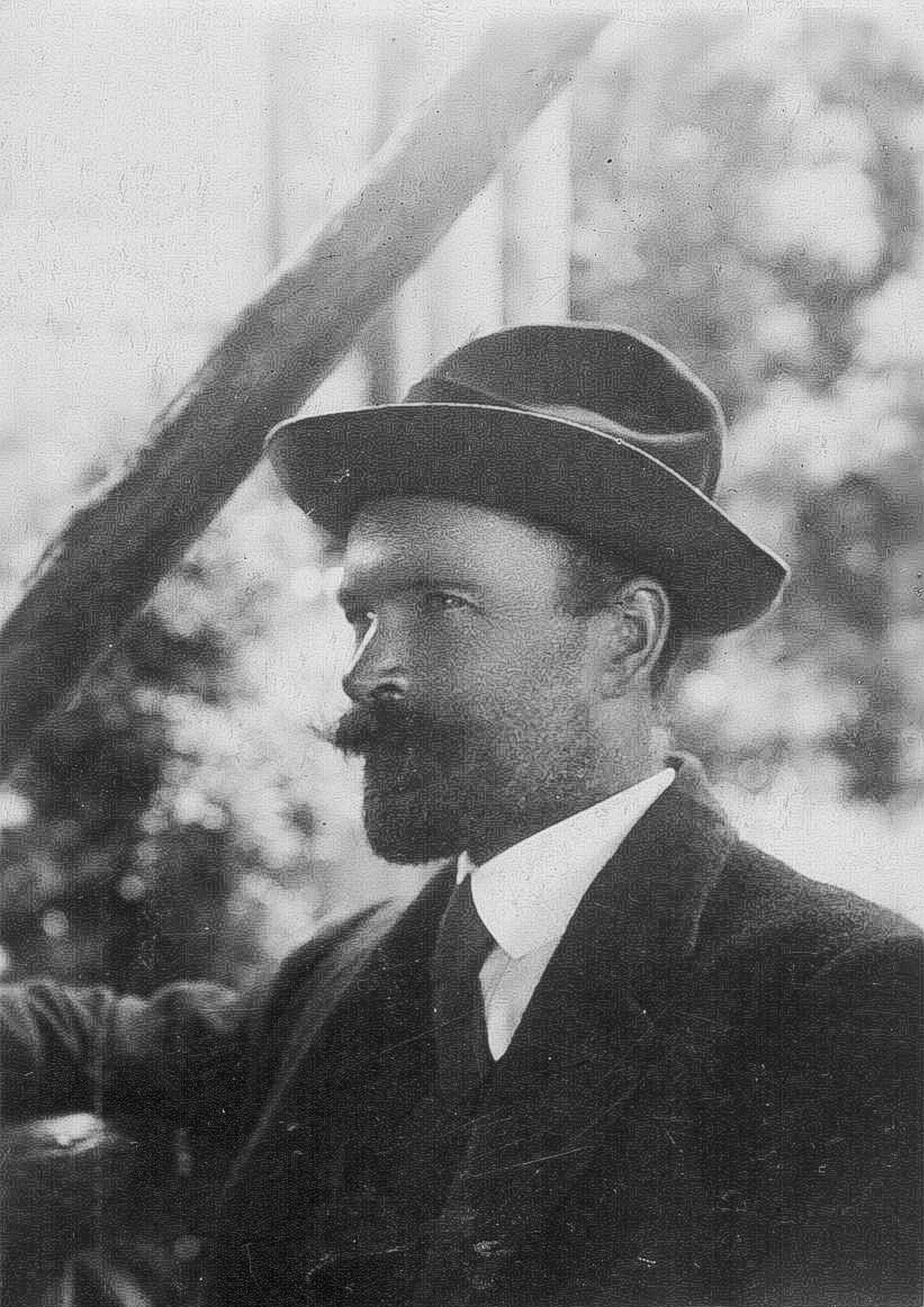
Who was this accomplished author? Many women lost it over the cultured Carinthian immigrant ensconced in his mountain eyrie. In 1923, for example, Weindorfer was snowed in with the scary South African Maude Van der Riet, who later penned an epistle called ‘The Cradle Mountain: a climb to the peak: the world’s view’. The 49-year-old nurse and writer described Weindorfer as
tall and thin like a young cedar tree, with a moustache turned skywards the color [sic] Titian raved about in all his pictures. Mountain air complexion; eyes, what eyes! They flashed like fork lightning on pointed swords …[3]
However, it is likely that the mailbag author visited Waldheim earlier, in 1922. The clue is the name Percy Lane, which appears to be an amalgam of two surnames of real people with a Waldheim connection: men called Percy and Lane were working at the Tasman Oil Company’s Barn Bluff shale oil mine. In his diaries Weindorfer recorded Percy and Lane arriving at Waldheim from Barn Bluff on 21 March 1922 and returning to the oil show next day. A Launceston party by the name of Joscelyne was staying at Waldheim at that time, and their day-by-day activities mostly match those described in ‘A dip into the Waldheim mailbag’: arriving on Quaile’s wagonette, then visiting Hounslow Heath, Dove Lake/Mount Campbell and the Cradle Mountain summit.
The names of the Joscelyne party members are recorded in the Waldheim Visitors Book. A poem by Vera M Scott appears as an entry for the period 14–25 March 1922:
A party of five to Cradle Mount came
To visit ‘mine host’, Weindorfer by name
So charming they found him
As they clustered around him
That they marvelled no more at his fame.
They soon settled down to his motto & creed
That ‘nothing else matters’ and ‘of time there’s no need’.
They devoured his puddings with spring water mixed
But after two helpings they found themselves fixed,
And with coffee to follow they had a good feed.
One fine morning they thought up the Cradle they’d climb
Having nothing to do, and plenty of time
So they all started out
With mine host for a scout
The dogs, meanwhile, barking a chime.
The old Cradle frowned down on this frivolous crowd
And said ‘I know well how to deal with the proud.
I’ll teach them to cheek me,
And with lightness to treat me,
I’ll send them home all humbly bowed’.
So they started to climb, arrived at the top,
And the Cradle smiled softly, and said ‘I’ll soon stop
These impertinent mortals
From storming my portals’.
Sure enough they reached ‘Waldheim’ just ready to drop.
Now this party of five had vocations in town
And so, most reluctantly, had to come down
From that land near to Heaven
Of which fun is the leaven
And ‘Waldheim’ itself is the crown.
The visitors book entry bears four other signatures: Lydia Morrison, J [Julius] Norman Piper, HS [Horace Samuel] Joscelyne and his wife HM [Harriet Mary, known as ‘Addie’] Joscelyne née Cumings.[4] All these people were middle-aged but, as Maude Van der Riet had shown, when it came to Weindorfer age did not preclude gushing. Horace Joscelyne was a Trevallyn grocer’s assistant, while Addie managed their house at 26 Delamere Crescent, Trevallyn, Launceston.[5] They had no children. Piper was a soon-to-be-married jeweller in Bourke Street, Launceston.[6] Scott, the visitors book poet, Morrison and Addie Joscelyne seem the most likely candidates for authorship of ‘A dip into the Waldheim mailbag’. It is unknown whether any of them practised as a romance writer, but one of them certainly had the skills to do so.
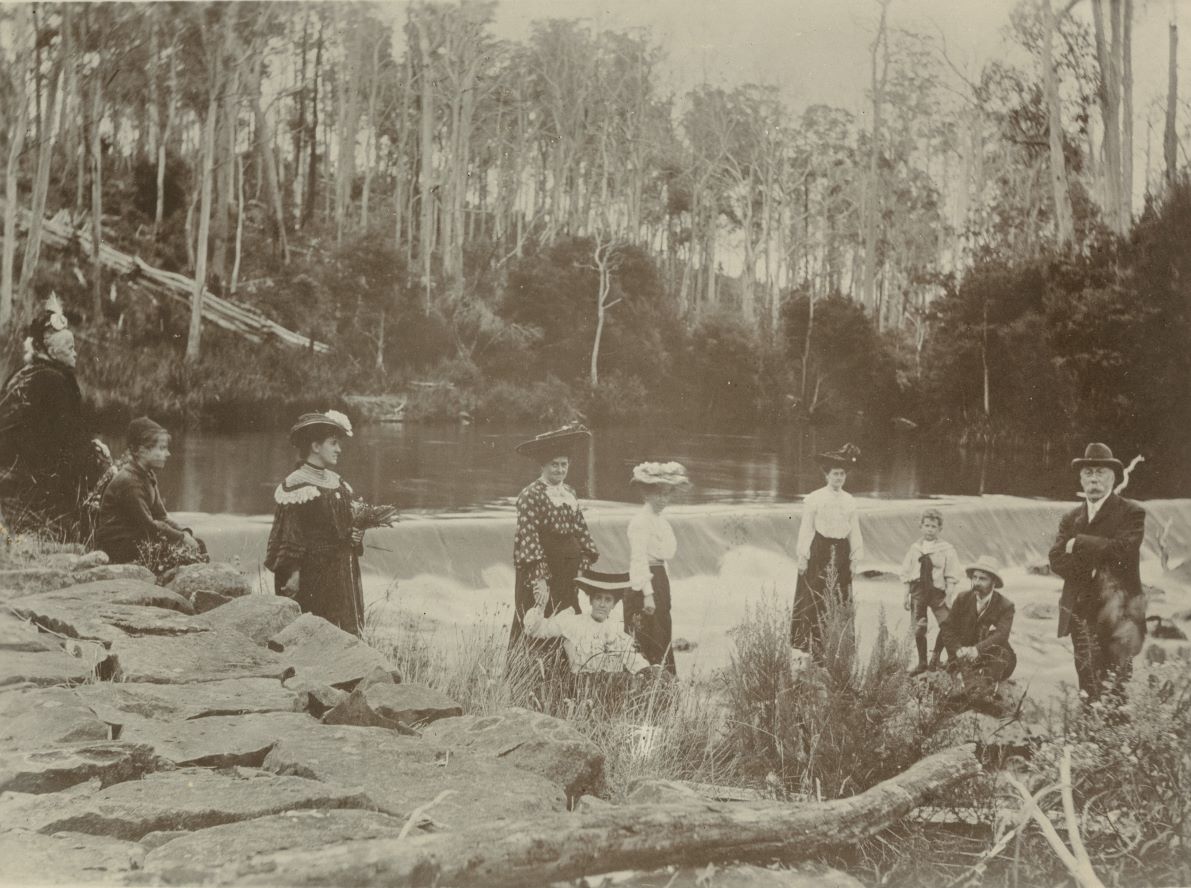
Vera May Scott (1886–1962)[7] was born at Battersea, London. At the 1901 British census she was a 15-year-old living in London with her 47-year-old piano tuner father Henry Sidney Scott and 37-year-old Brisbane-born mother May Scott.[8] No record of the family’s migration was found, but in 1922 Vera May Scott was an unmarried typist living at 28 Delamere Crescent, Trevallyn with her parents and sister Eleanor Scott.[9] Scott lived next door to the Joscelynes and had a strong connection to the family. In 1945 she thanked Horace Joscelyne for ‘unfailing kindness’ during her mother’s long illness.[10] Rupert William Joscelyne Hart, whom Scott recognised in her will, was the son of Horace Joscelyne’s sister Violet Mary Joscelyne.[11]
Lydia Morrison (1886–1971)[12] appears to have emigrated from England as a small child in 1891, along with her two-year-old brother and her parents, 28-year-old Lydia Morrison senior and 35-year-old farmer William Morrison.[13] In 1922 Lydia lived with her parents, her sister Dorothy Mary Morrison and brother William Morrison junior, at 211 St John Street, Launceston.[14] Forty-six years later in 1968 Lydia was still listed as an unmarried clerk—at 82 years of age—and living with her bookbinder sister at 6 Union Street, Launceston.[15]
Harriet (‘Addie’) Joscelyne née Cumings (c1872–1946) emigrated from England with her sister as a teenaged nursemaid in 1888. Her parents, Ebenezer and Caroline Cumings, had preceded her and were already Launceston residents.[16] Addie’s older sister Minnie gave her occupation in the passenger list as schoolteacher, and until her marriage in 1893 she operated the Trevallyn Preparatory School.[17] At this point Addie Cumings took over from her, continuing the school until at least 1897.[18] This suggests that she was at least reasonably well educated. Addie Cumings married Horace Samuel Joscelyne at Launceston in 1903.[19]
Tasmania’s great romance novelist of the time, Marie Bjelke Petersen, threatened to pen a Cradle Mountain tearjerker which never eventuated.[20] Given her habitual bible bashing, some may see that as a good thing, but a Bjelke Petersen blockbuster might have done wonders for Weindorfer’s business. It would be surprising if Bjelke Petersen hadn’t pencilled him in as a model for her male lead—like Robert Sticht in her Mount Lyell Mine saga Dusk (1921)—and Waldheim as her anonymous location. Like driver Vic Whyman in her Jewelled Nights (1923), Cradle Mountain coach driver Bob Quaile would surely have appeared under an alias in her new screed. Bjelke Petersen championed Tasmania’s great forests and mountain scenery, and as such may have looked askance at the ‘grass tree’ (Richea pandanifolia) bonfire in ‘A dip into the Waldheim mailbag’.
However, much of the latter text is straight out of the BP playbook. The unknown author’s heroine Claudia Crane even notes ‘I could not help thinking what rich material a novelist might find here’, before listing elements of the region’s romantic history. ‘Why go to other lands for the setting for tales of adventure, of love, and mystery?’ Why indeed? Cradle Mountain was a romance writer’s paradise waiting to be reimagined.
A DIP INTO THE WALDHEIM MAILBAG
From Claudia Crane to an invalid friend.
Wilmot
My dear Margaret,
I am on the eve of adventures strange and wonderful — bound for a lonely chalet in a mountain valley, 2000 feet above the sea level. How does that appeal to your romantic soul, oh! my friend? And, moreover, the said chalet is inhabited by a solitary man, who is cook, housemaid, washerwoman, waiter and guide rolled into one. Poor Aunt Grace is filled with the most dismal forebodings as to the dinners and beds we shall get, but to Mona (who has just turned sixteen) and myself, the prospect is most alluring — the uncertainty — the romance — of it all makes an irresistible appeal. (All the same we hope the dinners are good.)
On arriving we had a hearty welcome from Mr Quaile, a fine white haired, weather beaten old chap with a face like a rosy apple.[21] Mona christened him ‘Daddy’ on the spot and my heart warmed to him straight away as I caught the kindly, compassionate glance that just rested on my crooked shoulders. He led us on the verandah of a funny rather rambling little house and introduced us to the quaint, bright little hostess. When we trooped inside we found the place surprisingly roomy and comfy and we all approved of the cheery fire burning merrily in the open fireplace and straightaway fell in love with the inviting little white beds waiting for us. Now my inner woman having been well satisfied, I am writing this epistle in front of that same fire, with the lovliest [sic] pink lilies smiling down at me from the high mantel.
The little township seems to be a paradise for lilies. This afternoon as we were sitting on the grass in front of the house a lovely slip of a girl passed with a most beautiful cluster of the Golden Lily of Japan nestling in her arms peeping into her sweet oval face. I wonder who she is? She looked nearly as lovely as her lilies. We were favoured with many a kindly curious glance from the passers by [sic] and Mona was highly amused when one passing man called to us ‘You will find it cold up the mountains’.
Ah well that small white bed is calling me, so Good-night.
Yours,
Claudia (in search of adventure)
PS I find that the lovely girl is Daddy Q’s daughter.[22]
C.
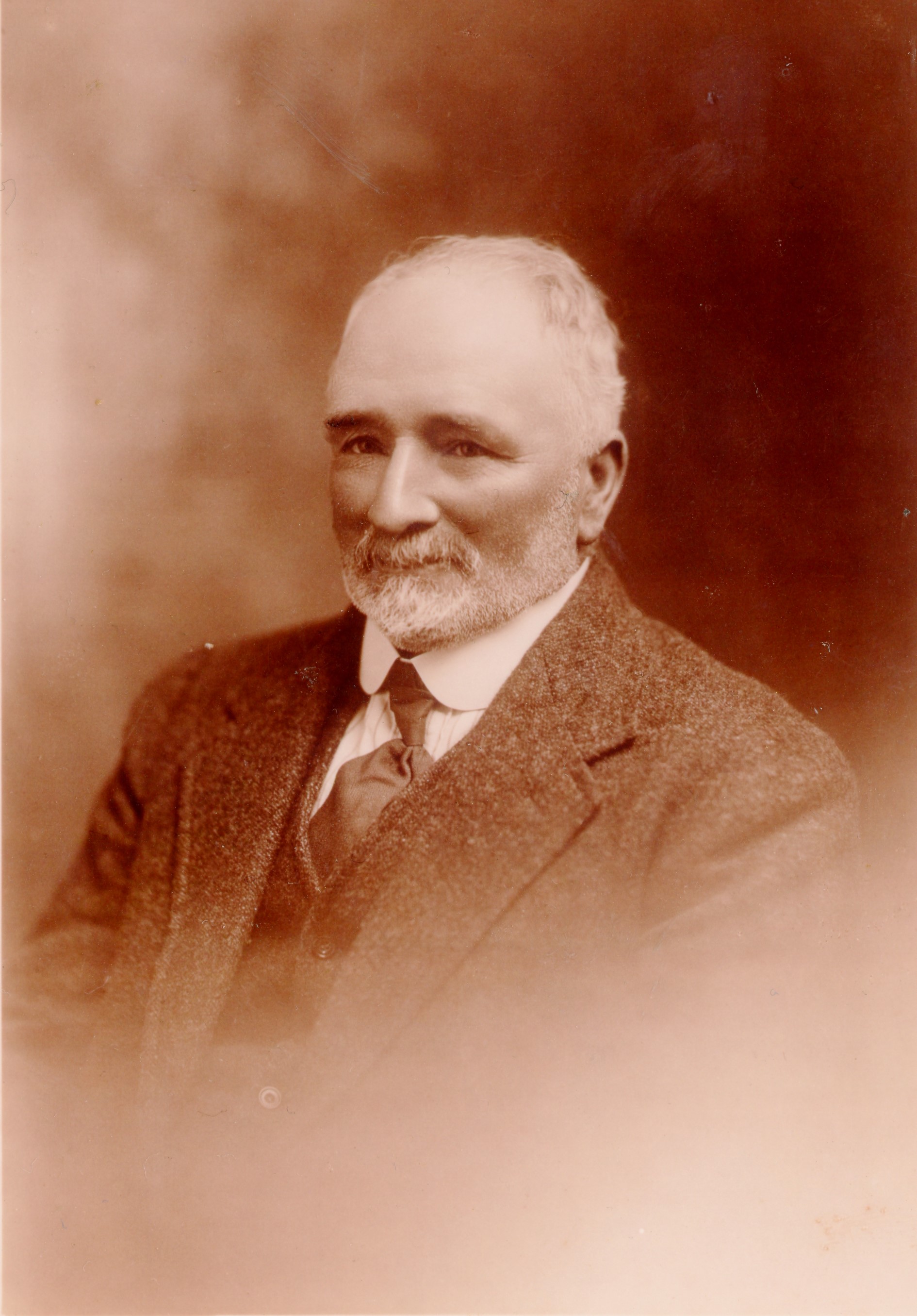
From Claudia to Margaret.
Dear Margaret,
We left the world behind at seven o’clock this morning, in the most glorious sunshine. Our vehicle was a weather beaten old warrior, and had evidently started life as a mailcoach [sic]. We were inclined to smile at it and our smiles broadened as our driver with a twinkle in his eyes, implored us to be careful of the upholstering, but before our journey ended we had a huge respect for our coach. We set off merrily along a very fine road, of which Daddy Q was very proud. He is evidently a man of many parts and equally at home as councillor, farmer, miner, road-maker, and moreover is no mean conversationalist.[23] He proved quite equal to carrying on several conversations at once, interspersed with various remarks to horses (sometimes with funny results, as for instance when the remark ‘Gee up, Commonwealth Bank’ nearly sent Mona into hysterics.) I had always had a vague idea that drivers of horses used fairly lurid language but, ‘Gee up! You lazy rubbish’! was about the most violent expression we heard — much to Mona’s disappointment. For the 1st time in my life, I found myself passing through mining country. We passed quite close to the ‘Shepherd and Murphy’, and Round Hill mines. Daddy Q also has a claim which he pointed out to us.[24] Further along the road we had quite a picturesque glimpse of a fine herd of wild cattle, grazing on a hillside. Great tracts of the country we passed through had been burnt, and I saw a variety of fence that was new to me —composed of simply of single huge trunks (mostly chared [sic]) laid end to end.
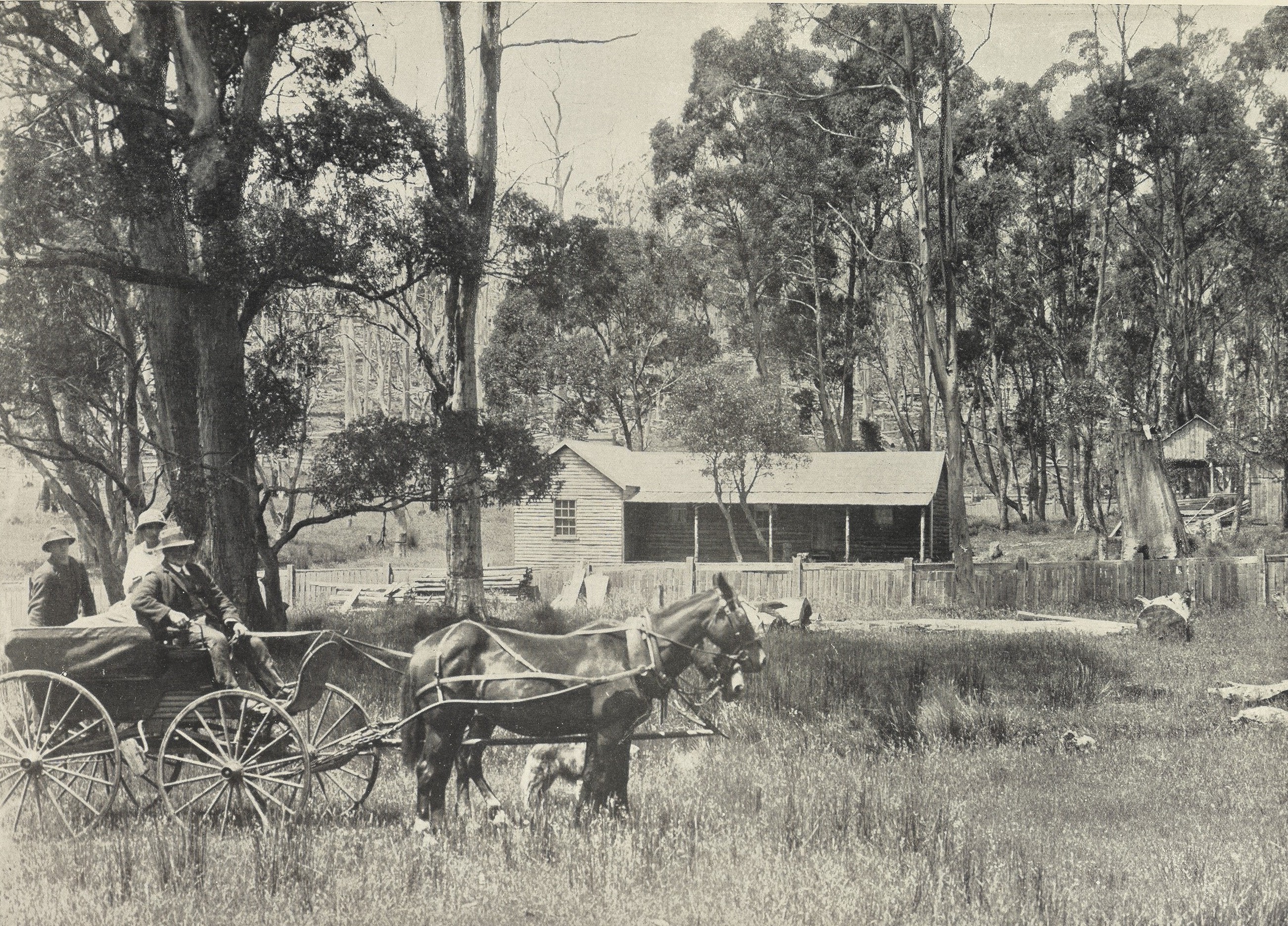
I liked the black and white effect. The quick eye of our driver distinguished some of his own cattle among others, and soon the truants were trotting along in front of us. By this time our fine road was left behind and we were passing along what we were assured was a ‘made road’, and nothing to what was in front of us.
We who were facing each other were bobbing and bowing to each other in a most absurd way. But it was a new experience to us and we rather enjoyed it, but nevertheless no-one grumbled when the horses were allowed to leave the ‘made road’ and take their way through paddocks to ‘Daisy Dell’, where quite our ideal dairy maid — fresh, comely and plump — served us with butter, cheese and cakes of the best. The horses were glad of the spell, as the road had been steadily ascending the whole way, and it was a pretty strenuous climb for them. We started once more, this time in a fine drizzling rain, which prevented our getting any of the early glimpses of the Cradle to which we had been looking forward.
Soon after we had passed Pencil Pine Creek and the Sawmill we came across a gang of men hard at work on the road, and there a halt was called, and our luggage had to be ‘packed’.[25] The girls decided to stroll on in the soft rain, and when the horses caught us up we could not help smiling at the poor pack horse — he looked for all the world like a camel with a huge hump. The decree went forth that we were to ride, to Mona’s huge delight and my inward dismay. But once mounted, I found it delightful to gaze round without troubling what my feet were doing.
The last three miles of our way lay along a lovely little green valley, much of it by the side of the Dove River. The 1st glimpses of our new home came rather unexpectedly, but a very pretty glimpse it was in spite of the rain. Soon we were at the porch and found ourselves welcomed, not by an old man, as we were expecting, but by a big dark-bearded man, in the prime of life.
We were soon lifted from the saddle and walked into the house on rather wobbly legs, to be greeted by a huge fire and a deep barking proceeding from under the couch. The barker proved to be ‘Flock’, a dignified and matronly old dog, who soon came out and made friends with us, together with her son, ‘Flick’ who is, according to his owner, ‘young and silly and spoiled by the ladies’. Our bedroom opens out of the living room and contains 4 bunks. Moss and lichen still clings to the small trees used as posts in the room, also to those supporting the bunks above our heads. The picture frames are of bark trimmed with lichen. The tassel on our blind is a dear little fir cone. The recess for our washstand (which I grieve to say looks uncommonly like a packing case, curtained,) is lighting by a tiny fascinating window made of three old negatives. The seats are merely lengths of tree trunk stood on end. The walls, of King Billy pine, are fine, each plank having a broad white streak running through it where the sap once ran. The rugs on our floor are badger skins, but the star room boasts a real carpet and a leopard skin, head and all.
I am too tired to write more to-night.
Yours,
Claudia.
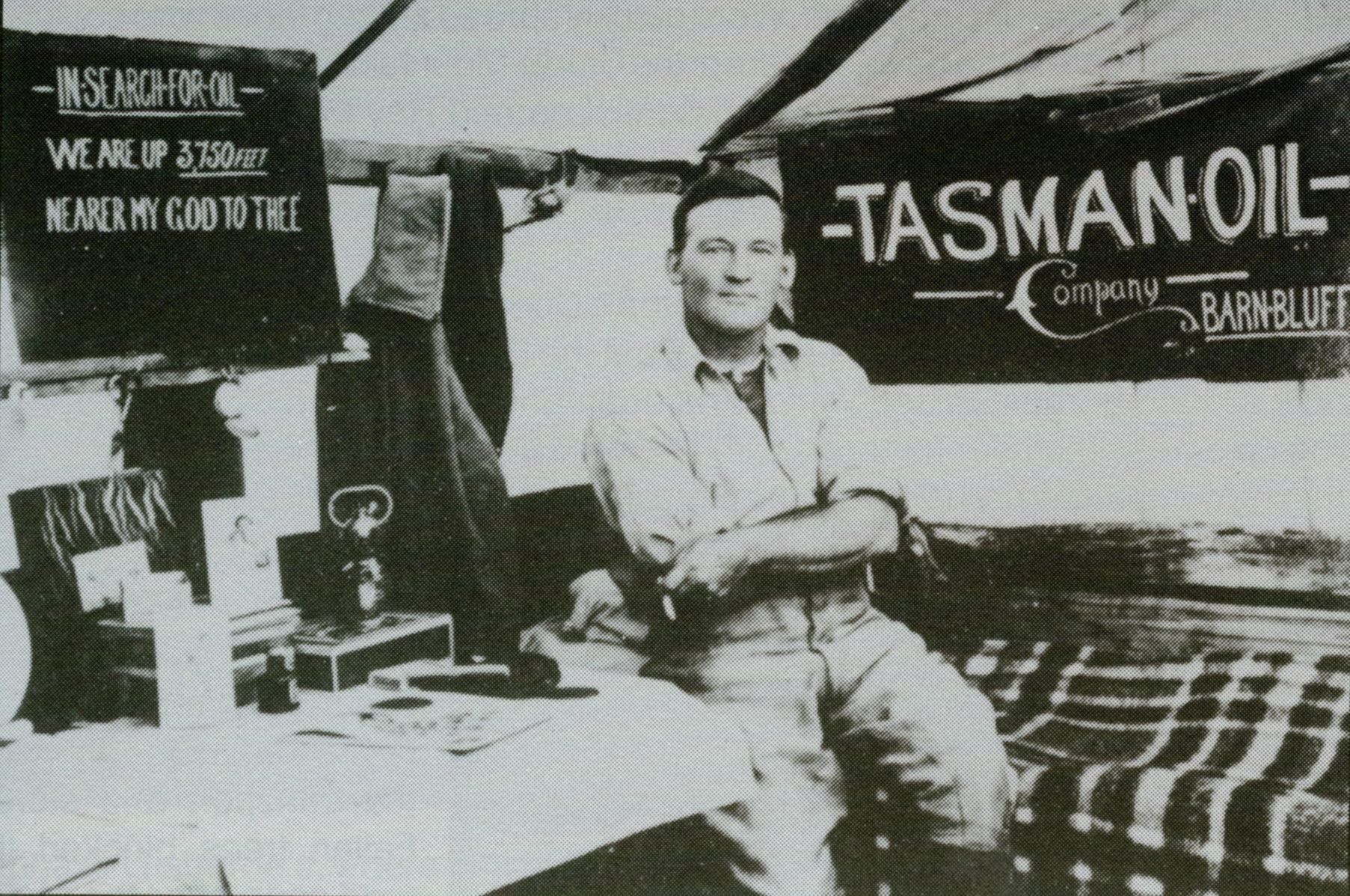
Mona to her girl friend [sic].
My Darling Marie,
Such a lovely thing has happened. A perfectly beautiful boy came here yesterday. He has most glorious brown eyes and a lovely big nose like Napoleon. His father and Dad used to be mates. His father is one of the directors in some mine here, and he worried his father till he let him come here to work, but now he is sick of it, and so Mum has asked him to come to town and stay for a holiday and it is such fun having him here, everyone else is pretty old except Claudia, she is a love, but she can’t tear round like I want to.[26] Percy had such a lark this morning. You know Mr W always brings us a cup of coffee before we get up. Well he knocked at the door and said ‘milk for the babies’ like he always does and I got on my elbow ready to take my cup (Claudia always get the tray — a bonza one made out of KB pine). When I looked up there was Percy grinning like a Cheshire cat and he had on the most beautiful silk pyjamas with purple stripes and a silk cord round the waist (Dad says he must be an awful fop to wear silk and he looked beautiful in them). I gave a most awful yell and nearly dropped the cup on the floor and Percy and I just squealed, it was so funny. We made such a row that everyone came trooping in to see the fun until Mum rapped on the wall and they all got for their lives.
Oh! I say Marie, did you know I had pretty ankles? Mr W served out leggings and putties to Mum and Claudia, but he wouldn’t give me any, because he said my ankles were the nicest he had seen for a long time and it was a pity to hide them. I thought perhaps he was stuffing, but he wasn’t because I asked Claudia, and she said it was quite true, she had often admired them. So that’s my first live compliment.
Mum is getting to be quite a sport up here — she doesn’t chip a bit. Every morning she goes out to the Kitchen for the Porridge jazz with the rest of us. We all streak out into the Kitchen like a lot of Oliver Twists and everyone grabs their own Porridge when Mr W puts it out and there is a procession back into the Dining-Room. But no-one ever asks for more, cos he gives us such big platefuls.
I do hate washing porridge pots at home, don’t you? But it is quite easy here the pot just gets stuck out on the roof until next morning and the Porridge comes off without any trouble. And he’s got quite a cute idea for washing windows, he just takes them right out and puts them in the Creek, and both sides are washed at once.
Mum doesn’t even mind getting her feet wet. You know coming out she wouldn’t even let me get out of the Trap to see the Pencil Pine Fall cos it was raining, and I might get my feet wet. But up here they are nearly always wet, and Mum thinks nothing of one foot slipping into a hole with water a foot deep in it. All the wet boots and stockings look so funny dangling round the fire place at night.
That Percy is pulling my hair so I’ll have to go and hammer him now so Ta-Ta, heaps of love.
Mona.
PS I hope you get that little note I sent by pigeon post. It was fun letting him go.
Mr John Moore to Percy’s father.
Dear Lane,
Suppose you will be somewhat surprised to note the address heading this letter — nearly as surprised as I was when your son rode in here. The lad had been sent over from the mine on an errand and was overjoyed to find our party. Truth to tell I think he is beginning to find the mine life a trifle monotonous and a short spell would [do] him no harm. Unless we hear from you to the contrary, therefore, it would give us great pleasure to keep him with us during our stay here and to take him home for a few weeks change. We would be glad if you would drop the manager a line and make this right for him. He and my little girl Mona have become great pals and are keeping all the old fogies alive with their harmless nonsense.
You should really take a spell and run over and see this place next summer. By that time the road will be right through and the accommodation even better than now, as our host has great plans for enlarging and improving the house and will probably have domestic help also.
At the present time he does the whole of the housework and cooking unaided, in addition to this work as guide, but expects the business will become far too large for that to continue possible [sic]. The wife was really rather worried about domestic arrangements, but our host soon proved he understood the important art of cooking a good dinner. On our first day we sat down to roast mutton, potatoes boiled in their skins and an excellent boiled ‘spring water’ pudding the flavouring of which aroused much curiosity among the ladies. As a matter of fact I found that ½ cup of rum was used and we have since had a similar concoction known as Barn Bluff pudding flavoured with port wine. Tip top coffee is the finishing touch to our meals. You will see that we are in no danger of starvation.
The house is unique, built almost entirely by our host. A picturesque porch opens into the dining room, 3 bed-rooms, the kitchen and wood shed open out of that, and one other bedroom out of the kitchen. There is an arrangement of curtains which can be drawn at will round the central part of the dining room to exclude draughts. Two long seats after the style of box couches run each side of the table and at the foot is an extremely solid arm chair cut from a tree trunk. The fire place is one of those huge affairs within which one can sit and is always garnished with a hug back log under which mine host can scarcely stagger. The kitchen is compact enough to be found on board ship and the owner can stand in the middle and reach almost anything he wants. By the way, we men, clad comfortably in pyjamas and slippers start most days in the kitchen with a good old yarn and smoke before the ladies are astir. You would enjoy those yarns. Most of the bedrooms are fitted with bunks, that occupied by my wife and self being the only one with ordinary beds. Our room also boasts a pretty little private balcony which the ladies have christened ‘The Juliet balcony.’ The tent room and the huts are some yards from the main buildings and are furnished with a couple of beds and a fire place with wood-shed attached, the hut having in addition a loft with an extra bed designed to accommodate mine host in times of pressure. The feature of the place however, is the bath room, a hut with its own small verandah standing on the brink of a creek a few yards from the house. Water is supplied from the creek by a most ingenious arrangement and may be heated in the copper which always stands on the huge fire place.
One thing I know will strongly attract you, there is a fine gramophone here, and a first class selection of records and we have enjoyed many a good concert as we sat round the fire after a long day’s tramp.
I should certainly like to come again next summer and possibly you can arrange to join our party then. However, we can discuss that at our next meeting.
Yours faithfully,
J Moore.
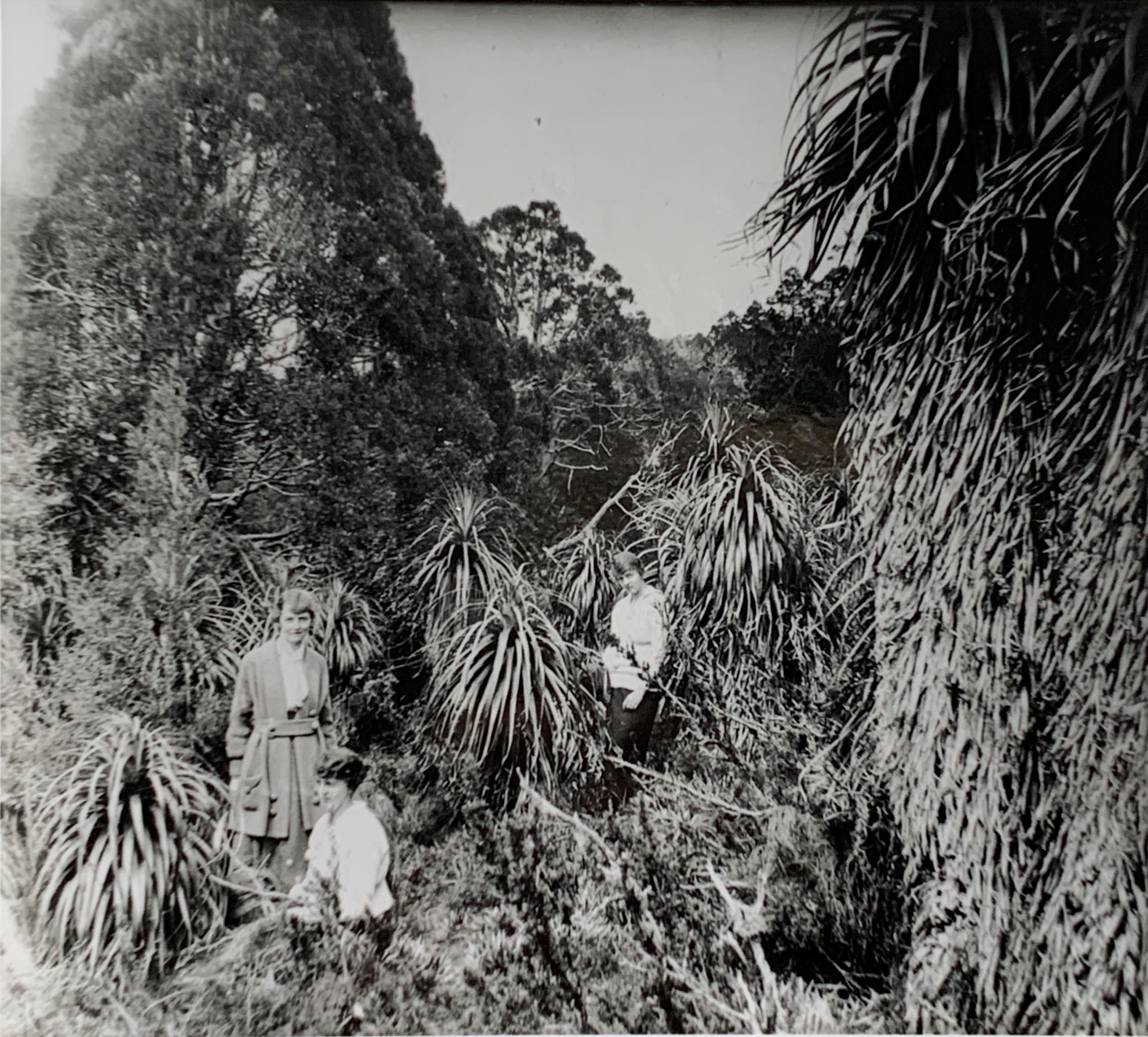
From Claudia
My Dear Margaret,
I want to tell you of some of our walks. The first was in most glorious sunshine. We crossed the dear little creek that runs past the chalet and followed the steep moss-bordered path that winds up through the gulley [sic]. Here I made the acquaintance of the famous beech which is the only native tree that sheds its leaves.[27] Its slender graceful stem is beautiful and you have no idea how pretty, glimpses of the blue sky, looked through the canopy of little green leaves. I was quite sorry when we came up into the open but when we reached the top of Hampstead Heath we had a glorious view on all sides — the mountains in front and away back the way we had come to Middlesex.[28]
We went for the same walk again later but wandered further away over the hills and had a lovely picnic boiling the billy in the approved bush fashion. It was a delightful sight to see my rather stately Aunt Grace devouring a huge slice of bread and butter on which was spread a tinned herring and enjoying it too.
I think our lovliest {sic] picnic spot was a little pebbly speech on the shores of Dove Lake. The beauty of the spot and even the sight of Cradle frowning down upon us, failed to subdue the irrepressibles, who were madly engaged in getting as much of the beach as possible down each others’ backs. So to keep them quiet we set them to work getting our lunch. Our host had once been busy on that beach making a raft and the pair found too paddles roughly cut out of planks. These they seized and pressed into service as bread board and meat dish respectively. Mona soon had a nice little pile of bread and butter on one end of their respective paddles and solemnly marched round and served the waiting circle.
Soon we found ourselves climbing up the gently sloping sides of Mt Campbell. Half way up, we rested on a lovely fragrant couch of wild thyme[29] —So now I can say ‘I know a bank where the wild thyme grows’ because I do (Talking of resting, in this part of the world — if you want to rest where the ground is wet and it generally is wet, here we find you simply sit or lie on the strong stunted bushes growing about a foot above the ground and you have a seat fit for a Queen.)
As we pushed on up the mountain to our surprise we came across two or three snowdrifts. Of course each one was the signal for a scramble between the children (and I regret to say not wholly confined to them) but soon they came across an even more attractive diversion. Percy found a huge kerosene plant and promptly set fire to it.[30] It was really marvellous the way that green plant blazed and the intense heat it gave. Mona yearned to set fire to everyone she came across after that but her father wouldn’t hear of her spoiling the scenery in that fashion.
One morning we woke to find all the world white and the chalet a fairy place. We only got occasional glimpses of the Little Horn when her misty veil floated aside for a second, but those glimpses were beautiful indeed. Of course Mona and Percy were just spoiling for a snow fight and her father and I were dragged out to see fair play. At least that is what we intended, but we soon found ourselves involved in the battle and enjoying it mightily. The child’s delight in all was pretty to see, and so was the pride in her father’s eyes as they rested on the glowing face, alight with mischief and triumph as a well-armed snowball slipped down Percy’s neck. Our little Mona will be a very lovely woman some day. Ah me! What would it be to be sixteen and straight![31]
After peace had been declared we struck into the trees above the clear slope which had been the battlefield, and found a lovely little path winding among the trees towards the world. You have no idea how fascinating it is to stroll among the pretty floating flakes of snow. We felt quite injured when presently it turned to rain and sleet — it seemed commonplace. As we turned to retrace our steps Percy begged us to climb a tiny hill that lay between us and the ‘Dove’, directly facing Cradle. So up we climbed and there lay before us the Dove valley, Mount Campbell, the little foothills and Cradle, all one dazzling white vision of loveliness. I have only to shut my eyes and I can see it all once more. I wish you could, you would love it so.
Yours,
Claudia.
Dear Margaret,
It has been wet the whole day through. Mona was roaming restlessly round, poking her little nose into most things, when she came upon a printed notice on the roof ‘Special apartment for naughty girls’. Of course she immediately demanded the history thereof, and there was something very like a twinkle in the eyes of our host as he told the story of two unfortunate girls who had been imprisoned there. ‘And you too shall go up for you are the most naughty of them all’. There was a wild shriek from Mona, a frantic rush to the door, and then ensued such a scuffle as you never did see. When it was all over and Mona was safely in prison Mine host shook his head mournfully as he mopped his heated brow. ‘And she was the heaviest of them all.’ Then there was a shout of laughter for a shower of ancient Bulletins and Couriers came tumbling about his ears from the trap door above and Percy was promptly hoisted up to keep the rebel in order.
It was such evident cruelty to keep those two shut up that Uncle John proposed that we should take them for a walk, in spite of the rain. So off we set with one of the other visitors acting as guide to explore the valley in a new direction. First he led us into a most beautiful bit of virgin forest. Trees hundreds of years old towered above us.
Long ghostly locks of pale lichen hung from many of the smaller ones — I never saw such lovely moss and as I have seen here. Only once have we seen ferns in any of the glades, and those only of a common variety, but the mosses are exquisite. Presently we struck down into the opening and tramped briskly over the springy turf, the children wrangling away as usual.
Presently I made out that Percy was affirming his ability to make a big fire in the rain, and Mona was stoutly doubting.
We came to a little valley dotted with grass trees[32] and Percy stepped in front of a huge fellow, burrowed among the dried leaves around the trunk, set fire to them and waited. We watched breathlessly and soon saw a wicked little flame creeping up the trunk and in among the green leaves, and in a few moments great banners of flame were waving defiance to the rain. When we left, nothing remained of the beautiful green tree but a black smoking stump, and we were warned not to say anything about it on our return, as mine host doesn’t like the scenery spoilt. Neither do I, but all the same I am glad I saw it once.
One misty morning we started for the top of the Cradle. We had been looking forward to seeing the mountain lakes but the heavy mist hid everything. As we stood above what we were told was Crater Lake, occasionally we could see a thin silver line of foam, the mist would part for a second, allow us one weird glimpse of the lake then blot it out once more. By the time we had got within ¼ mile of the mountain’s foot the mist had turned to a fine thick rain, and the wind was icy, so a council of war was held and we decided to turn homeward by another route. In spite of the discomfort we enjoyed the experience — it was entirely new to us. It really was extremely funny to be tramping along in the fine rain and not worrying in the least, an inch of cold water swishing about in our boots, our faces perpetually washed but never dried, and drops of water hanging from brows, lashes, hair, chin — in fact anywhere they could cling. It is so strange to shut one’s eyes and fell the cold fringe of wet eyelashes. It was weird too, to look back and see mysterious indistinct figures, some armed with staves, looming in the distance. However we were soon safely home, into dry clothes, and grilling over the big home fire the chops we had expected to grill at the mountain’s foot.
Bed-time now so good-night.
Yours,
Claudia.
My Dear Margaret,
We had blackberry jam for tea, and it started us speaking of the occasional blackberry brambles we passed on our way here always beside a little stream, then someone said they had sprung up from seeds from blackberry jam used by prospectors camping there. Being in a dreamy mood I started picturing to myself the scenes round those camp fires — the rough hard faces lit up by the fitful flames, and from that I fell to musing over the glimpses we had had of lives so different from our own and the unexpected traces of history across which we had come. I could not help thinking what rich material a novelist might find here in the rough life of the mining settlements scattered among the hills — the lonelier camps away back in the mountains — the sawmill at Pencil Pine — the pioneer gang pushing their road into the mountains — the exciting rounding up of the magnificent wild cattle — the old life of the VDL Coy at Middlesex — the oldtime Governor [sic] who visited there — the convicts who toiled up the mountains laden with timber for the observation posts — the stalwart foreigner in his lonely chalet with its mysterious trap doors — the weather-beaten old man-councillor, — farmer, roadmaker [sic], miner, — his slender daughter with her sweet oval face and her hands full of golden lilies — or as we saw her later clad in rough trousers and boots for her work in the farm yard — her lover slipping along in the dusk to give her a helping hand. Why go to other lands for the setting for tales of adventure, of love, and mystery?
My dear! I have inflicted a screed on you. But we go home the day after to-morrow — that must be my excuse. Soon this freer and easy life — where ‘time is not [important] and nothing matters’, the porridge jazz, the wash up symphony, the picnics enlivened by the gambols [sic] of Flick and Flock, Mona and Percy, the fireside evenings of music and pleasant talk, the eagerly looked for coming of Mr Quaile with letters and papers, the meetings with visitors will be things of the past.
However often we come here in the future it will never be under quite the same conditions, and I am so glad we came before things are made too easy and ordinary for us.
Claudia.
MY DEAR MARGARET,
There is a touch of novelty about this letter. It is being written at the foot of Cradle — just as we started out I stuffed some paper and a pencil into my pocket in case I had a chance to write a line. We are just back from the summit and are resting before returning home. It has been a perfectly glorious scramble and I have enjoyed every minute of it. When we stood at the foot and looked up at the strange rugged pile I wondered if I could do it, but it turned out to be fairly easy. As we ascended our guide led us to the opposite side of the mountain and I felt a pang of disappointment as he began to go down, because I could see higher peaks above us. But it was only for a moment and then he began to ascend once more, passing over the lovliest [sic] little green velvety moss carpets. The view from the top is magnificent, we seemed to stand in a centre of ever widening circles of mountains. It was strange to stand on the cairn of tree trunks which we were told had been hauled and built up by convicts and think of the hard toiling hands that had placed them there, and to look at the wonderful view and think of the bitter, unhappy eyes that have gazed upon it before ours.
The scramble down gave us plenty of exercise and our hands were quite as useful as our feet; at the foot, one after the other down we went on hands and knees to drink from a tiny stream flowing from the hillside, and never was water sweeter. Mona seems pretty tired — don’t know what she will be like when we get home — she and Percy have been in such wild spirits that they have covered six times as much ground as anyone else. You know there is a lake on the way named after a Launceston lady,[33] and Mona was much taken by it and has been looking for something to which to tack her own name ever since. Well, she and Percy were for once walking quietly along conversing amicably when suddenly there was a wild shout and Percy darted off and began dancing wildly round a shallow swampy pool. When the rest of us came up he just gasped out ‘Mona’s Marsh’ and took to his heels with the indignant Mona after him like a deer. However she is quite happy now for a certain tiny muddy pool on the tableland bears the legend ‘Percy’s Puddle’ printed in big wobbly letters across its muddy bosom.
Claudia.
PS And oh, the lakes and the mountain are beautiful in the sunshine, but I am so glad we saw them first in their weird misty mood. C.

My Dear Margaret,
It is 2 o’clock in the morning and I am sitting up in my bunk writing this by candlelight. I am far too happy to sleep so I will tell you of the wonderful thing that has happened. Mona was quite knocked up when we got back [from] Cradle and so it happened that I did not see the arrival of some new guests. I was busy putting her to bed and stayed with her till she was fast asleep. Then I slipped out to the group by the fire. Most of the men were so deep in the discussion of some mining affair that they did not notice me — all but one, quietly smoking and listening, on the edge of the group. He looked up and my dear! It was Dick! How long we stared at each other I do not know, nor how much of the wild gladness at my heart found its way into my face. But presently very quietly he rose, slipped back the curtain and drew me to the porch outside and oh my dear! Such a tangle of mistakes and misunderstandings we cleared up! All the happiness I ever dreamed of is mine. I know how glad you will be. And I am to be married to-morrow — no! It is to-day — I got into a panic at the bare idea but [Dick] only laughed at me and would have his way.
Yours Claudia,
(in a maze of happiness)
MRS JOHN MOORE TO HER SISTER.
My dear Mary,
The most unheard of thing has happened. Here we are at Wilmot and have left Claudia behind at that outlandish place. On our last night there John and myself happened to be left alone round the fire, when Dick Grey walked into the room and calmly asked John’s consent to marry Claudia next day.[34] He had turned up here early in the evening. Really for a moment I could only gasp. It appeared he met a parson staying at Daisy Dell as he came through and as it was bright moonlight, he proposed riding there at once, and bringing him here in the morning. I was really upset at the insane idea and as soon as I found breath enough I started straight for Claudia’s room. There she was, sitting on her bunk in the dark, ‘Claudia Crane, are you mad’? I demanded. When I had got the candle alight I could only gasp again. The little pale face was transfigured — flushed and smiling and sparkling the big eyes soft and shining. At sight of the radiant happiness shining in those eyes my irritation fell away like a garment. I did try to persuade her to come back to town and have a proper wedding but she was softly obstinate, she didn’t seem to think it mattered in the least that she had no trousseau or engagement ring or anything. And after all did it? As she had no relative nearer than ourselves, and we were all here, they were both old enough to be sure of themselves and they had wasted so much time already.

Why should they wait longer? So I had to give in, for after all I had not the slightest right to object. When Mona heard the news in the morning, she was wild with excitement and promptly took charge with all girl’s delight in a wedding. She insisted on doing the thing properly, invited herself to be bridesmaid, and Percy to be the best man, hunted out the one soft little white frock Claudia had with her and fixed up a big tulle scarf of mine for a veil. A wreath of ginsen flowers and sweet scented white daisies nestled in the soft hair, holding the veil in place. My tender-hearted little girl had carefully draped it so that the slight deformity about which Claudia is so sensitive, was scarcely apparent. She had even a bouquet of lovely white berries she had found growing near the house. They were married out on the porch facing the mountain. Even to my eyes the little bride was as sweet as a rose, and it did my heart good to see the rather quiet face of her groom light up at sight of her and to see his eyes grow infinitely tender as they rested on the shy winsome face and I wish you could have heard the serene confidence in the low voice of the bride. After a gay little wedding breakfast, with one of Mr W’s huge slabs of cake in the place of honour, we started for home. It was quite in keeping with the rest of the up-side-down [sic] proceedings that we should be the ones to go (to the strains of the wedding march our host put on the Gramophone) leaving the bride and groom behind for their honeymoon and I am afraid they were not quite as sorry to see the last of us as they should have been — if they were the content in their faces belied them. I am afraid you will be inclined to blame me for lack of firmness but really I do not see how I could have acted differently.
Your affectionate Sister
Grace.
[1] Kate Legge, Kindred: a Cradle Mountain love story, Melbourne University Press, 2019.
[2] NS573/1/1/11 (Tasmanian Archives, afterwards TA).
[3] Maude van der Riet, ‘The Cradle Mountain: a climb to the peak: the world’s view’, Daily Telegraph, 15 December 1923, p.9.
[4] Waldheim visitors book, vol.1, 1991:MS:0004 (Queen Victoria Museum and Art Gallery).
[5] Electoral roll, Division of Bass, Subdivision of Launceston West, 1922, p.31; entry for Harriet Mary (Addie) Cumings, Launceston Family Album, written by Lesley Morgan Blythe and Marion Sargent, https://www.launcestonfamilyalbum.org.au/detail/1030945/harriet-mary-addie-cumings, accessed 10 June 2023.
[6] Electoral roll, Division of Bass, Subdivision of Launceston West, 1922, p.43. Piper married Ada Letitia Isabel Scott, unrelated to Vera May Scott, in 1923.
[7] Years are from headstone, Carr Villa Memorial Park, Launceston; plus 1901 British Census as below.
[8] British Census, 1901, Administrative County of London, Civil Parish of Heathorn, p.22 (accessed through Ancestry.com.au).
[9] Electoral roll, Division of Bass, Subdivision of West Launceston, 1922, p.48. See also will of Henry Sidney Scott, in which he made his daughter Vera May Scott his sole executrix and beneficiary, will no.18727, AD960/1/56 (TA).
[10] ‘Thanks’, Examiner, 23 October 1945, p.2.
[11] See will no.43508, AD960/1/94 (TA).
[12] Years are from headstone, Carr Villa Memorial Park, Launceston.
[13] Passenger list for the Orana, October 1891, Series BT27, British National Archives (accessed through Ancestry.com.au).
[14] Electoral roll, Division of Bass, Subdivision of Launceston Central, 1922, p.34.
[15] Electoral roll, Division of Bass, Subdivision of Launceston Central, 1968, p.16.
[16] Descriptive list of immigrants, ss Coptic, arriving in Hobart 27 July 1888,. CB7/12/1/12–13, p.40 (TA), https://librariestas.ent.sirsidynix.net.au/client/en_AU/names/search/results?s=harriet+cumings&searchTarget=library&qu=harriet&qu=cumings, accessed 10 June 2023.
[17] ‘Current topics’, Launceston Examiner, 13 May 1893, p.5.
[18] See, for example, ‘Education’, Launceston Examiner, 4 January 1893, p.2; ‘Educational’, Daily Telegraph, 21 January 1896, p.4; ‘Diamond jubilee’, Launceston Examiner, 15 June 1897, p.6.
[19] Married 21 January 1903, registration no.608/1903, at St Paul’s Church, Launceston (TA).
[20] Gustav Weindorfer to RE Smith, 20 March 1920, NS234/17/1/4 (TA).
[21] Bob Quaile (1862–1942) was a well-known Wilmot identity, whose farmhouse just north of the village remains today as a barn. Quaile did much to open up Cradle Mountain as a tourist destination. For many years he operated a horse and wagonette service to Waldheim which was Gustav Weindorfer’s lifeline, the trip being broken at Quaile’s halfway house Daisy Dell. Quaile was a Kentish councillor and member of the Cradle Mountain Reserve Board.
[22] In 1922 Quaile had only one unmarried daughter, Sarah Ellen Quaile, born in 1897 and therefore 25 years old at the time of the Joscelyne party’s visit to Waldheim.
[23] Quaile was not a miner but had shares in the revamped Great Caledonian Gold Mine at Middlesex.
[24] The Great Caledonian Gold Mine.
[25] The FH Haines sawmill was on the site of the present-day Peppers Cradle Mountain Lodge.
[26] That is, Percy Lane’s father was involved in the Tasman Oil Company mine at Barn Bluff.
[27] Nothofagus gunnii.
[28] Claudia is describing the track through what is now known as Weindorfers Forest to Hounslow (not Hampstead) Heath. Weindorfer’s track was later replaced by the present track in that direction, cut by Lionel Connell and his sons.
[29] Lemonthyme (Boronia citriodora). It has a strong scent which some liken to that of lemon.
[30] Several Tasmanian plants seem to have borne the colloquial name ‘kerosene bush’ because of their flammability, but here the author seems to be referring to Richea pandanifolia.
[31] Claudia refers to her physical form rather than her sexual orientation!
[32] Richea pandanifolia.
[33] The ‘lake named after a Launceston lady’ is Lake Lilla, named by Stephen Spurling III after his sister in 1905.
[34] The idea of a Waldheim wedding was perhaps inspired by the legend of the naming of the Honeymoon Islands in Dove Lake. Weindorfer is meant to have rowed a couple to this improbable honeymoon spot, serenading them as he dipped the oar.
